Deck 2: Applications of the Derivative
Question
Question
Question
Question
Question
Question
Question
Question
Question
Question
Question
Question
Question
Question
Question
Question
Question
Question
Question
Question
Question
Question
Question
Question
Question
Question
Question
Question
Question
Question
Question
Question
Question
Question
Question
Question
Question
Question
Question
Question
Question
Question
Question
Question
Question
Question
Question
Question
Question
Question
Question
Question
Question
Question
Question
Question
Question
Question
Question
Question
Question
Question
Question
Question
Question
Question
Question
Question
Question
Question
Question
Question
Question
Question
Question
Question
Question
Question
Question
Question

Unlock Deck
Sign up to unlock the cards in this deck!
Unlock Deck
Unlock Deck
1/93
Play
Full screen (f)
Deck 2: Applications of the Derivative
1
Points A, B, and C lie on the graph of a function f(x), as shown on the diagram. What are the signs of f(x), f'(x), and f''(x) at the point C? Enter your answer as just "neg", "pos", or 0 in the order given above separated by commas. 

pos, 0, neg
2
Let F(x) be the function graphed below. For what value is F'(x) > 0? 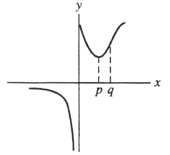
A) p < x < q
B) 0 < x < q
C) x > p
D) x < 0 and x > p
E) none of these

A) p < x < q
B) 0 < x < q
C) x > p
D) x < 0 and x > p
E) none of these
x > p
3
Is this the graph of a function having the following properties?
(I) asymptotic to the line y = x - 1
(II) relative maximum at x = 0

(I) asymptotic to the line y = x - 1
(II) relative maximum at x = 0

True
4
At which labeled point(s) is the graph concave down? 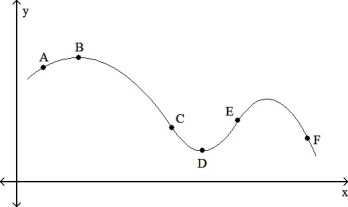
A) B
B) A, B
C) A, B, F
D) A, F

A) B
B) A, B
C) A, B, F
D) A, F

Unlock Deck
Unlock for access to all 93 flashcards in this deck.
Unlock Deck
k this deck
5
Is this the graph of a function having the following properties?
(I) concave down for all x
(II) asymptotic to the line x = 0
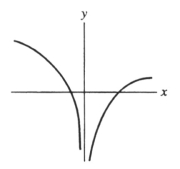
(I) concave down for all x
(II) asymptotic to the line x = 0


Unlock Deck
Unlock for access to all 93 flashcards in this deck.
Unlock Deck
k this deck
6
Which labeled point has the most negative slope? 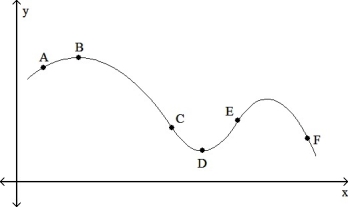
A) E
B) D
C) F
D) C

A) E
B) D
C) F
D) C

Unlock Deck
Unlock for access to all 93 flashcards in this deck.
Unlock Deck
k this deck
7
At which labeled point(s) is the function increasing? 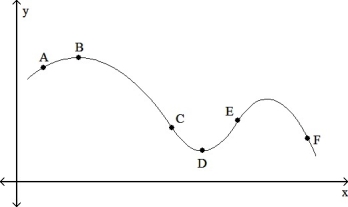
A) A
B) A, E
C) C, F
D) E

A) A
B) A, E
C) C, F
D) E

Unlock Deck
Unlock for access to all 93 flashcards in this deck.
Unlock Deck
k this deck
8
Which of the following graphs could represent a function with the following properties?
I. f(x) > 0, for x < 0
II. (x) ? 0, for all x
III. (0) = 0
A)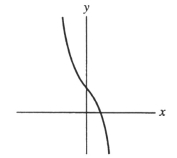
B)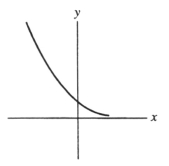
C)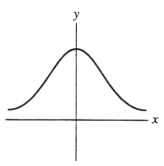
D) none of these
I. f(x) > 0, for x < 0
II. (x) ? 0, for all x
III. (0) = 0
A)

B)

C)

D) none of these

Unlock Deck
Unlock for access to all 93 flashcards in this deck.
Unlock Deck
k this deck
9
Let a, b, and c be fixed numbers with a > 0 and let f(x) = + bx + c. Which of the following properties is true of the graph of f(x) ?
A) f(x) is always concave up
B) f(x) has either a relative maximum or inflection point
C) f(x) has one relative maximum
D) f(x) has one inflection point
E) none of these
A) f(x) is always concave up
B) f(x) has either a relative maximum or inflection point
C) f(x) has one relative maximum
D) f(x) has one inflection point
E) none of these

Unlock Deck
Unlock for access to all 93 flashcards in this deck.
Unlock Deck
k this deck
10
Which labeled point has the most positive slope? 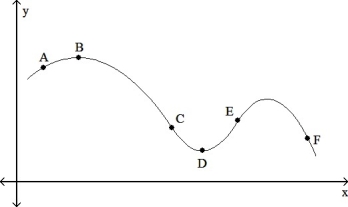
A) A
B) E
C) B
D) F

A) A
B) E
C) B
D) F

Unlock Deck
Unlock for access to all 93 flashcards in this deck.
Unlock Deck
k this deck
11
Is this the graph of the function having the following properties?
(I) inflection point at x = 3
(II) no relative maximum point
(III) asymptote at x = 5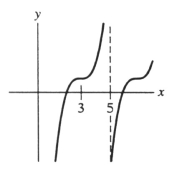
(I) inflection point at x = 3
(II) no relative maximum point
(III) asymptote at x = 5


Unlock Deck
Unlock for access to all 93 flashcards in this deck.
Unlock Deck
k this deck
12
Is this the graph of a function having the following properties?
(I) f'(x) < 0 for all x
(II) f''(x) > 0 for all x < 0
(III) (0, 1) is a point on the graph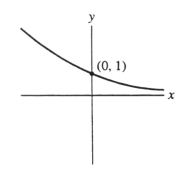
(I) f'(x) < 0 for all x
(II) f''(x) > 0 for all x < 0
(III) (0, 1) is a point on the graph


Unlock Deck
Unlock for access to all 93 flashcards in this deck.
Unlock Deck
k this deck
13
Is this the graph of a function having the following properties?
(I) defined for x ≥ -1
(II) horizontal asymptote at y = 3
(III) increasing for all x ≥ -1
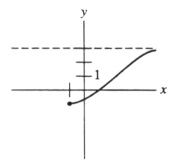
(I) defined for x ≥ -1
(II) horizontal asymptote at y = 3
(III) increasing for all x ≥ -1


Unlock Deck
Unlock for access to all 93 flashcards in this deck.
Unlock Deck
k this deck
14
Is this the graph of a function having the following properties?
(I) f'(x) > 0 for all x
(II) f''(x) > 0 for all x < 0, f''(x) < 0 for x >0
(III) asymptotes at y = , y = -
(I) f'(x) > 0 for all x
(II) f''(x) > 0 for all x < 0, f''(x) < 0 for x >0
(III) asymptotes at y = , y = -


Unlock Deck
Unlock for access to all 93 flashcards in this deck.
Unlock Deck
k this deck
15
Is this the graph of a function having the following properties?
(I) x-intercept at x = -2
(II) absolute maximum at x = -1
(III) relative maximum at x = 1
(IV) concave up for x ≥ 2
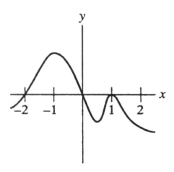
(I) x-intercept at x = -2
(II) absolute maximum at x = -1
(III) relative maximum at x = 1
(IV) concave up for x ≥ 2


Unlock Deck
Unlock for access to all 93 flashcards in this deck.
Unlock Deck
k this deck
16
At which labeled point(s) is the function decreasing? 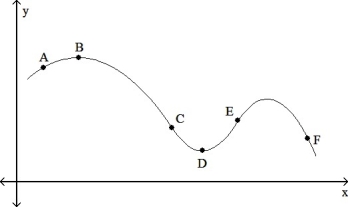
A) F
B) A, E
C) C, F
D) C

A) F
B) A, E
C) C, F
D) C

Unlock Deck
Unlock for access to all 93 flashcards in this deck.
Unlock Deck
k this deck
17
At which labeled point(s) is the graph concave up? 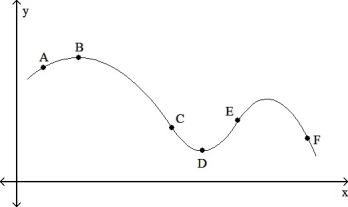
A) D
B) C, E
C) C, D, E
D) C, D

A) D
B) C, E
C) C, D, E
D) C, D

Unlock Deck
Unlock for access to all 93 flashcards in this deck.
Unlock Deck
k this deck
18
Which of the following could represent a function having the given properties?
(I) increasing slope for x < 4
(II) f'(x) > 0 for all x (x ≠ 4)
(III) asymptote at x = 4
A)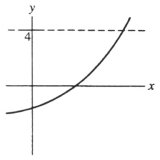
B)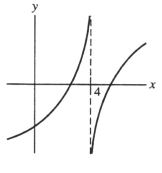
C)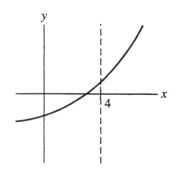
D)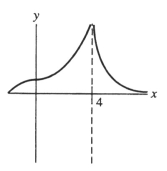
(I) increasing slope for x < 4
(II) f'(x) > 0 for all x (x ≠ 4)
(III) asymptote at x = 4
A)

B)

C)

D)


Unlock Deck
Unlock for access to all 93 flashcards in this deck.
Unlock Deck
k this deck
19
Is this the graph of a function having the following properties ?
(I) f(0) = -5
(II) f'(0) = 0
(III) f''(0) = 12
(IV) f( ) = f(- ) = -12

(I) f(0) = -5
(II) f'(0) = 0
(III) f''(0) = 12
(IV) f( ) = f(- ) = -12


Unlock Deck
Unlock for access to all 93 flashcards in this deck.
Unlock Deck
k this deck
20
Which of the following graphs could represent a function having the given properties?
(I) asymptotes x = 2 and x = -2
(II) f''(x) > 0 for all x
(III) f(x) > 0 for all x > 4
A)
B)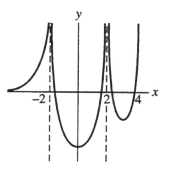
C)
D)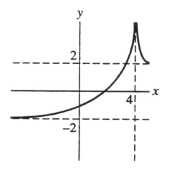
(I) asymptotes x = 2 and x = -2
(II) f''(x) > 0 for all x
(III) f(x) > 0 for all x > 4
A)

B)

C)

D)


Unlock Deck
Unlock for access to all 93 flashcards in this deck.
Unlock Deck
k this deck
21
Determine the inflection point of  Enter your answer exactly as just an ordered pair of fractions:
Enter your answer exactly as just an ordered pair of fractions: 
 Enter your answer exactly as just an ordered pair of fractions:
Enter your answer exactly as just an ordered pair of fractions: 

Unlock Deck
Unlock for access to all 93 flashcards in this deck.
Unlock Deck
k this deck
22
Find the inflection point(s) of
A)
B) (2, f(2)) and (3, f(3))
C) x = -2, -3
D) (10, f (10))
E)
A)
B) (2, f(2)) and (3, f(3))
C) x = -2, -3
D) (10, f (10))
E)

Unlock Deck
Unlock for access to all 93 flashcards in this deck.
Unlock Deck
k this deck
23
Find the x coordinates of all relative extreme points of
A) x = -2, 0, 3
B) x = 0
C) x = -3, 0, 2
D) x = -3, 2
E) x = -2, 3
A) x = -2, 0, 3
B) x = 0
C) x = -3, 0, 2
D) x = -3, 2
E) x = -2, 3

Unlock Deck
Unlock for access to all 93 flashcards in this deck.
Unlock Deck
k this deck
24
If a function has second derivative f ''(x) = ( - 4) is (0, 0) an inflection point?

Unlock Deck
Unlock for access to all 93 flashcards in this deck.
Unlock Deck
k this deck
25
Find the x coordinates of all relative extreme points of
A) x = 2, 6
B) x = -4, -3, 0
C) x = 3, 4
D) x = 0, 3, 4
E) x = -4, -3
A) x = 2, 6
B) x = -4, -3, 0
C) x = 3, 4
D) x = 0, 3, 4
E) x = -4, -3

Unlock Deck
Unlock for access to all 93 flashcards in this deck.
Unlock Deck
k this deck
26
Find the inflection point(s) of y = 2 - 3 - 12x + 17.
A)
B) and
C) and
D) (2, -3)
E) none of these
A)
B) and
C) and
D) (2, -3)
E) none of these

Unlock Deck
Unlock for access to all 93 flashcards in this deck.
Unlock Deck
k this deck
27
Find the maximum value of the function f(x) = -  + 6
+ 6  + 10 for x ≥ 0.
+ 10 for x ≥ 0.
Enter your answer exactly as: f(a) = b rel max
 + 6
+ 6  + 10 for x ≥ 0.
+ 10 for x ≥ 0.Enter your answer exactly as: f(a) = b rel max

Unlock Deck
Unlock for access to all 93 flashcards in this deck.
Unlock Deck
k this deck
28
Find the inflection point(s) of .
A)
B) (2, f (2)) and (6, f (6))
C) (56, f (56))
D) (3, f (3)) and (4, f (4))
E)
A)
B) (2, f (2)) and (6, f (6))
C) (56, f (56))
D) (3, f (3)) and (4, f (4))
E)

Unlock Deck
Unlock for access to all 93 flashcards in this deck.
Unlock Deck
k this deck
29
Where is the function f(x) = increasing?
A) for x > 2
B) at x = 30
C) for all x
D) none of these
A) for x > 2
B) at x = 30
C) for all x
D) none of these

Unlock Deck
Unlock for access to all 93 flashcards in this deck.
Unlock Deck
k this deck
30
Find the relative minimum point(s) of
A) (-2, f(-2)) and (0, f(0))
B) (2, f(2)) and (-5, f(-5))
C) (-2, f(-2)) and (5, f(5))
D) (0, f(0))
E) none of these
A) (-2, f(-2)) and (0, f(0))
B) (2, f(2)) and (-5, f(-5))
C) (-2, f(-2)) and (5, f(5))
D) (0, f(0))
E) none of these

Unlock Deck
Unlock for access to all 93 flashcards in this deck.
Unlock Deck
k this deck
31
Which of the following is (are) true of
(I) (1, 7) is a point of inflection
(II) f(2) is a relative maximum point
(III) f has a relative minimum point at x = 0
(IV) f is increasing on (2, ?)
A) II, III, and IV
B) I, II, and III
C) II and III
D) all of these
E) none of these
(I) (1, 7) is a point of inflection
(II) f(2) is a relative maximum point
(III) f has a relative minimum point at x = 0
(IV) f is increasing on (2, ?)
A) II, III, and IV
B) I, II, and III
C) II and III
D) all of these
E) none of these

Unlock Deck
Unlock for access to all 93 flashcards in this deck.
Unlock Deck
k this deck
32
Determine the relative maximum point of  Enter your answer as exactly just an ordered pair of integers: (a, b)
Enter your answer as exactly just an ordered pair of integers: (a, b)
 Enter your answer as exactly just an ordered pair of integers: (a, b)
Enter your answer as exactly just an ordered pair of integers: (a, b)
Unlock Deck
Unlock for access to all 93 flashcards in this deck.
Unlock Deck
k this deck
33
Determine all the values of x where relative maximum and minimum points of the function  occur. Distinguish the maxima from the minima using the second derivative rule. Enter your answer exactly as: f(a) rel max, f(b) rel min in that order.
occur. Distinguish the maxima from the minima using the second derivative rule. Enter your answer exactly as: f(a) rel max, f(b) rel min in that order.
 occur. Distinguish the maxima from the minima using the second derivative rule. Enter your answer exactly as: f(a) rel max, f(b) rel min in that order.
occur. Distinguish the maxima from the minima using the second derivative rule. Enter your answer exactly as: f(a) rel max, f(b) rel min in that order.
Unlock Deck
Unlock for access to all 93 flashcards in this deck.
Unlock Deck
k this deck
34
Find the relative extreme points for
A) (5, f(5)) is a relative extreme minimum point, (-1, f(-1)) a relative extreme maximum
B) (0, f(0)) is a relative extreme minimum point
C) (5, f(5)) is a relative extreme maximum point, (-1, f(-1)) a relative extreme minimum
D) (-5, f(-5)) is a relative extreme maximum point, (1, f(1)) a relative extreme minimum
E) (-5, f(-5)) is a relative extreme minimum point, (1, f(1)) a relative extreme maximum
A) (5, f(5)) is a relative extreme minimum point, (-1, f(-1)) a relative extreme maximum
B) (0, f(0)) is a relative extreme minimum point
C) (5, f(5)) is a relative extreme maximum point, (-1, f(-1)) a relative extreme minimum
D) (-5, f(-5)) is a relative extreme maximum point, (1, f(1)) a relative extreme minimum
E) (-5, f(-5)) is a relative extreme minimum point, (1, f(1)) a relative extreme maximum

Unlock Deck
Unlock for access to all 93 flashcards in this deck.
Unlock Deck
k this deck
35
This is the graph of f(x) = 
 -
- 
 - 6x. What is the inflection point?
- 6x. What is the inflection point?
Enter your answer exactly as just an ordered pair of reduced fractions of form , or integers (a, b), or the word "none".
, or integers (a, b), or the word "none". 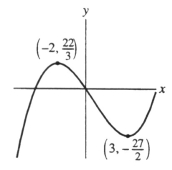

 -
- 
 - 6x. What is the inflection point?
- 6x. What is the inflection point?Enter your answer exactly as just an ordered pair of reduced fractions of form
 , or integers (a, b), or the word "none".
, or integers (a, b), or the word "none". 

Unlock Deck
Unlock for access to all 93 flashcards in this deck.
Unlock Deck
k this deck
36
Find the interval(s) where f is concave down for
A)
B) (-?, 0) ? (3, ?)
C)
D) (-?, 0) ?
E) (-?, 0)
A)
B) (-?, 0) ? (3, ?)
C)
D) (-?, 0) ?
E) (-?, 0)

Unlock Deck
Unlock for access to all 93 flashcards in this deck.
Unlock Deck
k this deck
37
If the second derivative of a function is is (2, f(2)) an inflection point'

Unlock Deck
Unlock for access to all 93 flashcards in this deck.
Unlock Deck
k this deck
38
Find the x coordinates of all relative extreme points of
A) x = -4, -3, 0
B) x = -4, -3
C) x = 3, 4
D) x = 2, 6
E) x = 0, 3, 4
A) x = -4, -3, 0
B) x = -4, -3
C) x = 3, 4
D) x = 2, 6
E) x = 0, 3, 4

Unlock Deck
Unlock for access to all 93 flashcards in this deck.
Unlock Deck
k this deck
39
Find the x coordinates of all relative extreme points of
A) x = -3, 0, 1
B) x = -1, 0, 3
C) x = -3, 1
D) x = 0
E) x = -1, 3
A) x = -3, 0, 1
B) x = -1, 0, 3
C) x = -3, 1
D) x = 0
E) x = -1, 3

Unlock Deck
Unlock for access to all 93 flashcards in this deck.
Unlock Deck
k this deck
40
Find the interval(s) where f is concave up for
A) (-?, ?)
B) (-?, 0) ?
C)
D)
E)
A) (-?, ?)
B) (-?, 0) ?
C)
D)
E)

Unlock Deck
Unlock for access to all 93 flashcards in this deck.
Unlock Deck
k this deck
41
Which of the following is (are) true of
(I) f is decreasing on (1, ?)
(II) (1, f(1)) is a relative minimum point
(III) f is concave down everywhere
(IV) (0, 0) is an inflection point
A) I and III
B) I, II, and III
C) II, III, and IV
D) I, III, and IV
E) all of these
(I) f is decreasing on (1, ?)
(II) (1, f(1)) is a relative minimum point
(III) f is concave down everywhere
(IV) (0, 0) is an inflection point
A) I and III
B) I, II, and III
C) II, III, and IV
D) I, III, and IV
E) all of these

Unlock Deck
Unlock for access to all 93 flashcards in this deck.
Unlock Deck
k this deck
42
Which of the following is (are) true of
(I) (0, 0) is an inflection point
(II) is an inflection point
(III) (0, f(0)) is a relative minimum point
(IV) f is increasing on (0, 2)
A) I, II, and III
B) I, II, and IV
C) I and II
D) I, III, and IV
E) all of these
(I) (0, 0) is an inflection point
(II) is an inflection point
(III) (0, f(0)) is a relative minimum point
(IV) f is increasing on (0, 2)
A) I, II, and III
B) I, II, and IV
C) I and II
D) I, III, and IV
E) all of these

Unlock Deck
Unlock for access to all 93 flashcards in this deck.
Unlock Deck
k this deck
43
Which of the following best represents the graph of y = 2 - 3 - 12x + 17 near the point (2, -3)?
A)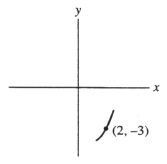
B)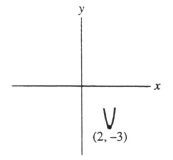
C)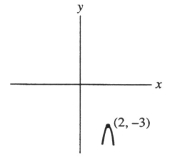
D)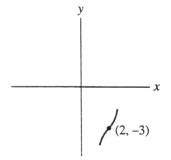
A)

B)

C)

D)


Unlock Deck
Unlock for access to all 93 flashcards in this deck.
Unlock Deck
k this deck
44
Is this the graph of f(x) = 9x + 1 + , x > 0?



Unlock Deck
Unlock for access to all 93 flashcards in this deck.
Unlock Deck
k this deck
45
Which of the following is the graph of F(x) = 2x - + 5?
A)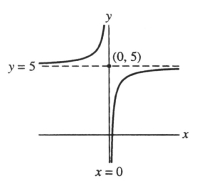
B)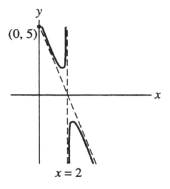
C)
D)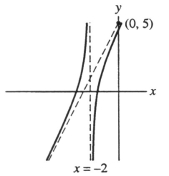
A)

B)

C)

D)


Unlock Deck
Unlock for access to all 93 flashcards in this deck.
Unlock Deck
k this deck
46
Is this the graph of the function f(x) = + 3 - 45x + 10?
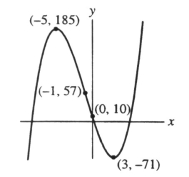


Unlock Deck
Unlock for access to all 93 flashcards in this deck.
Unlock Deck
k this deck
47
Is this the graph of f(x) = + 1?



Unlock Deck
Unlock for access to all 93 flashcards in this deck.
Unlock Deck
k this deck
48
Which of the following most resembles the graph of f(x) = near x = ?
A)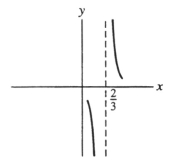
B)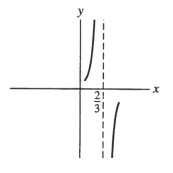
C)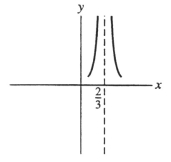
D)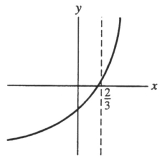
A)

B)

C)

D)


Unlock Deck
Unlock for access to all 93 flashcards in this deck.
Unlock Deck
k this deck
49
Is this the graph of y = ?
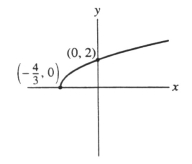


Unlock Deck
Unlock for access to all 93 flashcards in this deck.
Unlock Deck
k this deck
50
Which of the following is the graph of f(x) = - 9?
A)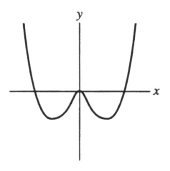
B)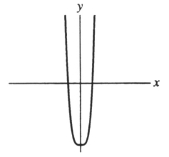
C)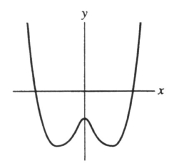
D)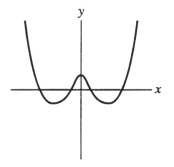
A)

B)

C)

D)


Unlock Deck
Unlock for access to all 93 flashcards in this deck.
Unlock Deck
k this deck
51
Is this the graph of the function f(x) = + 3 + 9x - 15?
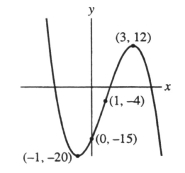


Unlock Deck
Unlock for access to all 93 flashcards in this deck.
Unlock Deck
k this deck
52
Is this the graph of f(x) = - + 2?



Unlock Deck
Unlock for access to all 93 flashcards in this deck.
Unlock Deck
k this deck
53
Which of the following is (are) true of
(I) f increasing on (1, ?)
(II) (1, 1) is a relative extreme point
(III) (1, 1) is an inflection point
(IV) f is concave up on (-?, 1)
A) II, III, and IV
B) I and III
C) I, II, and IV
D) I, II, and III
E) all of these
(I) f increasing on (1, ?)
(II) (1, 1) is a relative extreme point
(III) (1, 1) is an inflection point
(IV) f is concave up on (-?, 1)
A) II, III, and IV
B) I and III
C) I, II, and IV
D) I, II, and III
E) all of these

Unlock Deck
Unlock for access to all 93 flashcards in this deck.
Unlock Deck
k this deck
54
Is this the graph of g(x) = 2 + 3 - 12x - 5?
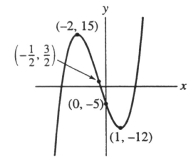


Unlock Deck
Unlock for access to all 93 flashcards in this deck.
Unlock Deck
k this deck
55
Find the interval(s) where f is increasing and concave down for  Enter your answer in standard interval notation as either: (a, b) or (a, b)∪(c, d) where a< c with any irrational numbers in lowest terms of form: e ±
Enter your answer in standard interval notation as either: (a, b) or (a, b)∪(c, d) where a< c with any irrational numbers in lowest terms of form: e ± 
 Enter your answer in standard interval notation as either: (a, b) or (a, b)∪(c, d) where a< c with any irrational numbers in lowest terms of form: e ±
Enter your answer in standard interval notation as either: (a, b) or (a, b)∪(c, d) where a< c with any irrational numbers in lowest terms of form: e ± 

Unlock Deck
Unlock for access to all 93 flashcards in this deck.
Unlock Deck
k this deck
56
Which of the following is the graph of y = + 2x + 5?
A)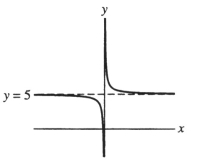
B)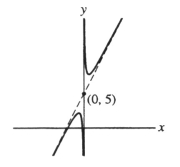
C)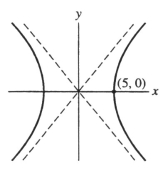
D)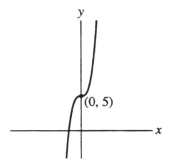
A)

B)

C)

D)


Unlock Deck
Unlock for access to all 93 flashcards in this deck.
Unlock Deck
k this deck
57
Is this the graph of h(x) = x + 10 + ?
Enter just the word "yes" or "no" (lower case).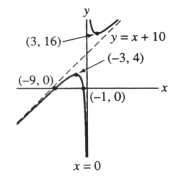
Enter just the word "yes" or "no" (lower case).


Unlock Deck
Unlock for access to all 93 flashcards in this deck.
Unlock Deck
k this deck
58
Is this the graph of f(x) = ?
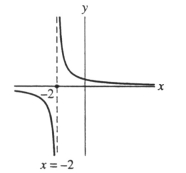


Unlock Deck
Unlock for access to all 93 flashcards in this deck.
Unlock Deck
k this deck
59
Is this the graph of f(x) = - 3 + 2?
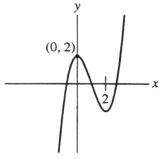


Unlock Deck
Unlock for access to all 93 flashcards in this deck.
Unlock Deck
k this deck
60
What are the x-intercepts of the graph of y = 3 + 24?
A) (24, 0)
B) (2, 0)
C) (0, -2)
D) (0, 24)
E) none of these
A) (24, 0)
B) (2, 0)
C) (0, -2)
D) (0, 24)
E) none of these

Unlock Deck
Unlock for access to all 93 flashcards in this deck.
Unlock Deck
k this deck
61
The graph of a function f(x) is sketched below. Which of the following is f(x)? 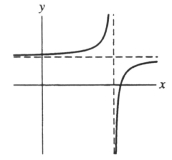
A) f(x) =
B) f(x) = - 2
C) f(x) = + 2
D) f(x) = - 5x - 2

A) f(x) =
B) f(x) = - 2
C) f(x) = + 2
D) f(x) = - 5x - 2

Unlock Deck
Unlock for access to all 93 flashcards in this deck.
Unlock Deck
k this deck
62
Determine the minimum value of x + y when xy = 100 (x > 0, y > 0).
Enter just an integer.
Enter just an integer.

Unlock Deck
Unlock for access to all 93 flashcards in this deck.
Unlock Deck
k this deck
63
A rectangular garden is to be fenced in and divided into three parallel sections. The fencing for the boundary costs $20 per foot whereas the fencing for the dividing fences costs $5 per foot. Consider the problem of finding the dimensions of the largest garden possible if the gardener can spend $2000 for the fencing. Find the values of l and w for which the total area of the garden is as large as possible. 


Unlock Deck
Unlock for access to all 93 flashcards in this deck.
Unlock Deck
k this deck
64
A rectangular garden of area 50 square feet is to be surrounded on three sides by a fence costing $2 per running foot and on one side by a brick wall costing $6 per running foot. Let x be the length of the brick wall side. Which of the following represents the total cost of the material?
A) 3x + (50 - x)
B) 6x +
C) 6x +
D)
E) none of these
A) 3x + (50 - x)
B) 6x +
C) 6x +
D)
E) none of these

Unlock Deck
Unlock for access to all 93 flashcards in this deck.
Unlock Deck
k this deck
65
Determine the minimum value of f(x) = 
Enter just an integer.

Enter just an integer.

Unlock Deck
Unlock for access to all 93 flashcards in this deck.
Unlock Deck
k this deck
66
A homebuilder's advertisement promises a house with a finished recreation room of 300 square feet. Two perpendicular walls of the room are to be paneled at a cost of $5 per running foot. A third side will be built out of windows at a cost of $10 per running foot. What dimensions should the room have to minimize the homebuilder's cost? Enter your answer as: length of side using cinder, length of other side.

Unlock Deck
Unlock for access to all 93 flashcards in this deck.
Unlock Deck
k this deck
67
Determine the minimum value of 
Enter just an integer.

Enter just an integer.

Unlock Deck
Unlock for access to all 93 flashcards in this deck.
Unlock Deck
k this deck
68
Suppose f(x) is the function graphed below. Which of the following is f(x)? 
A) f(x) = + 5
B) f(x) = + + 3x
C) f(x) = + 3x
D) f(x) = + 6 + 9x
E) f(x) = - + 2x + 5

A) f(x) = + 5
B) f(x) = + + 3x
C) f(x) = + 3x
D) f(x) = + 6 + 9x
E) f(x) = - + 2x + 5

Unlock Deck
Unlock for access to all 93 flashcards in this deck.
Unlock Deck
k this deck
69
A manufacturer estimates that the profit from producing x units of a commodity is dollars per week. What is the maximum profit he can realize in one week?
A) $300
B) $275
C) $500
D) $400
E) none of these
A) $300
B) $275
C) $500
D) $400
E) none of these

Unlock Deck
Unlock for access to all 93 flashcards in this deck.
Unlock Deck
k this deck
70
Determine the maximum value of f(x) = -2  + 6x + 3 on 0 ≤ x ≤ 2.
+ 6x + 3 on 0 ≤ x ≤ 2.
Enter just an integer.
 + 6x + 3 on 0 ≤ x ≤ 2.
+ 6x + 3 on 0 ≤ x ≤ 2.Enter just an integer.

Unlock Deck
Unlock for access to all 93 flashcards in this deck.
Unlock Deck
k this deck
71
The graph of a function f(x) is sketched below. Which of the following is f(x)? 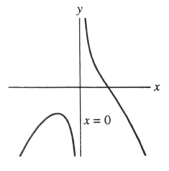
A) f(x) = -
B) f(x) = - x
C) f(x) = - -
D) f(x) =

A) f(x) = -
B) f(x) = - x
C) f(x) = - -
D) f(x) =

Unlock Deck
Unlock for access to all 93 flashcards in this deck.
Unlock Deck
k this deck
72
Suppose a ball is thrown into the air and after t seconds has a height of feet. When will it reach its maximum height?
A) 5 sec
B) 300 sec
C) 0.5 sec
D) 2.5 sec
E) none of these
A) 5 sec
B) 300 sec
C) 0.5 sec
D) 2.5 sec
E) none of these

Unlock Deck
Unlock for access to all 93 flashcards in this deck.
Unlock Deck
k this deck
73
A large rectangular garden is to be enclosed by a fence and divided into 5 regions by 4 parallel fences across the interior of the garden as shown below.  Find the values of l and w for which the total area of the garden is as large as possible, assuming that 120 ft of fencing is available.
Find the values of l and w for which the total area of the garden is as large as possible, assuming that 120 ft of fencing is available.
 Find the values of l and w for which the total area of the garden is as large as possible, assuming that 120 ft of fencing is available.
Find the values of l and w for which the total area of the garden is as large as possible, assuming that 120 ft of fencing is available.
Unlock Deck
Unlock for access to all 93 flashcards in this deck.
Unlock Deck
k this deck
74
Determine all maximum and minimum values of f(x) = -  + 3
+ 3  + 9x - 1 on
+ 9x - 1 on  Enter your answer exactly as: a,b both integers where a is the minimum of f and b is the maximum of f.
Enter your answer exactly as: a,b both integers where a is the minimum of f and b is the maximum of f.
 + 3
+ 3  + 9x - 1 on
+ 9x - 1 on  Enter your answer exactly as: a,b both integers where a is the minimum of f and b is the maximum of f.
Enter your answer exactly as: a,b both integers where a is the minimum of f and b is the maximum of f.
Unlock Deck
Unlock for access to all 93 flashcards in this deck.
Unlock Deck
k this deck
75
What is the maximum area that can be enclosed in a rectangular shape with 100 feet of fence if one of the two long sides is not fenced (there is a natural boundary there)?
A) 1000 square feet
B) 2500 square feet
C) 625 square feet
D) 1250 square feet
E) none of these
A) 1000 square feet
B) 2500 square feet
C) 625 square feet
D) 1250 square feet
E) none of these

Unlock Deck
Unlock for access to all 93 flashcards in this deck.
Unlock Deck
k this deck
76
Determine the minimum value of f(x) =  - 3
- 3  + 2 on 1 ≤ x ≤ 3.
+ 2 on 1 ≤ x ≤ 3.
Enter just an integer.
 - 3
- 3  + 2 on 1 ≤ x ≤ 3.
+ 2 on 1 ≤ x ≤ 3.Enter just an integer.

Unlock Deck
Unlock for access to all 93 flashcards in this deck.
Unlock Deck
k this deck
77
Compute the maximum product for two positive numbers with the property that the sum of the first plus five times the second is 5000.
A) 25,000
B) 1,250,000
C) 600
D) 50,000
E) none of these
A) 25,000
B) 1,250,000
C) 600
D) 50,000
E) none of these

Unlock Deck
Unlock for access to all 93 flashcards in this deck.
Unlock Deck
k this deck
78
A rectangular corral with a total area of 60 square meters is to be fenced off and then divided into 2 rectangular sections by a fence down the middle.  The fencing for the outside costs $9 per running meter, whereas that for the interior dividing fence costs $12 per running meter. Which of the following statements hold, if the cost (c) of the fencing is to be maximized? (I) The constraint equation is 3w + 2 l = 60 .
The fencing for the outside costs $9 per running meter, whereas that for the interior dividing fence costs $12 per running meter. Which of the following statements hold, if the cost (c) of the fencing is to be maximized? (I) The constraint equation is 3w + 2 l = 60 .
(II) The objective equation is 2l ∙ w = 60 .
(III) The constraint equation is w ∙ l = 60 .
(IV) The objective equation is C = 30w + 18l .
(V) The constraint equation is C = 12w + 9wl .
(VI) The objective equation is C = 60 - lw .
A) III and IV
B) V and VI
C) I and II
D) none of these
 The fencing for the outside costs $9 per running meter, whereas that for the interior dividing fence costs $12 per running meter. Which of the following statements hold, if the cost (c) of the fencing is to be maximized? (I) The constraint equation is 3w + 2 l = 60 .
The fencing for the outside costs $9 per running meter, whereas that for the interior dividing fence costs $12 per running meter. Which of the following statements hold, if the cost (c) of the fencing is to be maximized? (I) The constraint equation is 3w + 2 l = 60 .(II) The objective equation is 2l ∙ w = 60 .
(III) The constraint equation is w ∙ l = 60 .
(IV) The objective equation is C = 30w + 18l .
(V) The constraint equation is C = 12w + 9wl .
(VI) The objective equation is C = 60 - lw .
A) III and IV
B) V and VI
C) I and II
D) none of these

Unlock Deck
Unlock for access to all 93 flashcards in this deck.
Unlock Deck
k this deck
79
Determine the maximum and minimum values of f(x) = 1 -  + 3x + 2 on 0 ≤ x ≤ 3 .
+ 3x + 2 on 0 ≤ x ≤ 3 .
Enter your answer exactly as: a,b both integers where a is the minimum of f and b is the maximum of f.
 + 3x + 2 on 0 ≤ x ≤ 3 .
+ 3x + 2 on 0 ≤ x ≤ 3 .Enter your answer exactly as: a,b both integers where a is the minimum of f and b is the maximum of f.

Unlock Deck
Unlock for access to all 93 flashcards in this deck.
Unlock Deck
k this deck
80
Determine the maximum and minimum values of f(x) =  - 3
- 3  - 9x on -4 ≤ x ≤ 4 .
- 9x on -4 ≤ x ≤ 4 .
Enter your answer exactly as: a,b both integers where a is the minimum of f and b is the maximum of f.
 - 3
- 3  - 9x on -4 ≤ x ≤ 4 .
- 9x on -4 ≤ x ≤ 4 .Enter your answer exactly as: a,b both integers where a is the minimum of f and b is the maximum of f.

Unlock Deck
Unlock for access to all 93 flashcards in this deck.
Unlock Deck
k this deck



